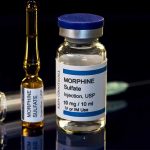Over 68,600 Americans are estimated to have died from opioid overdoses in 2020 alone, according to the National Institute for Drug Abuse (NIDA). This accounts for over two-thirds of all American drug overdose deaths during the same period.
But while many may wish to end their opioid use or opioid abuse, dependence and physical withdrawal symptoms can present major obstacles to addiction recovery.
What Is Opioid/Opiate Withdrawal?
Opioid analgesics like heroin, oxycodone, morphine, and fentanyl work by binding to opioid receptors in the brain and central nervous system, changing how the body responds to pain and relieving stress and anxiety. They also cause sedation, a slowing of central nervous system activity.
In response, the body tends to reduce the sensitivity of its opioid receptors, which reduces the effects of both illicit and prescription opioid drugs, as well as the body’s own natural endorphins.
If a person stops taking opioids after opioid dependence has formed, the body’s balance is once again thrown off in the opposite direction, which can cause painful or uncomfortable side effects until a new, drug-free internal balance is sorted out.
Dependence Vs. Addiction
Dependence can form after any chronic opioid use, and many who use opioid treatment to manage chronic pain may also develop physical dependence.
Opioid addiction, on the other hand, is a behavioral disorder of cravings and compulsive use of opioid drugs outside of medical necessity.
Many who abuse opioid drugs because of addiction, known medically as opioid use disorder, develop physical dependence as well. And physical dependence is often more severe when opioid drugs are abused in high doses for their euphoric effects.
Opioid Withdrawal Symptoms
Symptoms of opioid withdrawal, also known as opioid withdrawal syndrome, may vary depending on the individual, the opioid(s) involved, and the severity of dependence, motivation, attitude, and environment.
Symptoms are often described as flu-like, and may include:
- anxiety
- agitation
- cramping
- drug cravings
- diarrhea
- goosebumps
- increased heart rate
- increased blood pressure
- insomnia
- muscle aches
- nausea and vomiting
- restless legs
- runny nose
- sweating
- yawning
Heavy opioid use and long-term use of opioids (over six months) are linked with the most severe withdrawal symptoms, as well as potential complications like PAWS.
Opioid Withdrawal Timeline
The timeline for opioid withdrawal depends on which specific opioid drug a person has been taking, and whether that drug was short-, intermediate-, or long-acting. This is because:
- short-acting or slow-release opioids tend to generate a more rapid onset and fast progression through withdrawal symptoms
- longer-acting opioids generate delayed but drawn-out withdrawal symptoms
A general progression of opioid withdrawal symptoms and potential timelines includes:
Initial Withdrawal Symptoms (6-24 hours after last dose)
As the drug is removed from the body, you may develop mild symptoms like trouble sleeping, yawning, and feelings of agitation.
Acute Withdrawal Symptoms Progress & Peak (1-7 days after last dose)
As the drug is fully removed it can trigger potentially severe and escalating physical effects that resemble the flu (sweating, headaches, loss of appetite, aches and pains, etc.), as well as mental symptoms of drug cravings, anxiety, mood changes, and brain fog.
Withdrawal Symptoms Subside (5-14 days after last dose)
After peaking, your withdrawal symptoms may begin to lighten and subside, often resolving around one week after your last dose.
At this point the body has reversed many of the changes that allowed it to tolerate high doses of opioid drugs, which can greatly increase your risk of harmful or fatal overdose if you relapse.
Post-Acute Withdrawal Syndrome (PAWS)
Post-acute withdrawal syndrome (PAWS) is a condition that occurs after an extended period of heavy opioid abuse. It involves lingering symptoms of depression, poor concentration, low energy, poor sleep, and difficulty feeling pleasure from non-drug sources.
PAWS can last for weeks or months, though it does resolve over time.
Treatment For Opioid Withdrawal Symptoms
Even though opioid withdrawal symptoms are rarely life-threatening on their own, they can be extremely challenging. Different treatment options for opioid withdrawal management have been developed and approved for usu, including:
- medical detoxification, which manages the withdrawal process in a comfortable, medically supervised setting, often using medications like benzodiazepines to manage severe symptoms
- tapering, or rather than quitting cold-turkey, clinicians gently taper-down your dosage over time
- medication-assisted treatment (MAT), including methadone (a long-acting opioid agonist) and buprenorphine/naloxone (a partial opioid agonist and opioid antagonist combination) to manage cravings and withdrawal symptoms
These interventions are only a portion of a comprehensive treatment program for substance use disorder, which may also include inpatient or outpatient treatment, counseling, behavioral therapy, peer support programs, and aftercare support.
To learn about our outpatient substance abuse treatment programs, please contact us today.
Read More About Opioid Addiction:
- List Of Strongest Opioids
- What Are Synthetic Opioids?
- How Do Opioids Work?
- How Long Do Opioids Stay In Your Urine?
- Opioid Or Opiate?
Sources
- American Society of Addiction Medicine (ASAM) — Diagnostic and Statistical Manual of Mental Disorders (DSM-5) Criteria for Diagnosis of Opioid Use Disorder
- National Institute on Drug Abuse (NIDA) — Overdose Death Rates
- National Library of Medicine: MedlinePlus — Opiate and opioid withdrawal
- National Library of Medicine: StatPearls — Opioid Withdrawal
- Substance Abuse and Mental Health Services Administration (SAMHSA) — Medication-Assisted Treatment (MAT)
Written by
Northeast Addition Editorial Team
©2024 Northeast Addition Center | All Rights Reserved
This page does not provide medical advice.





